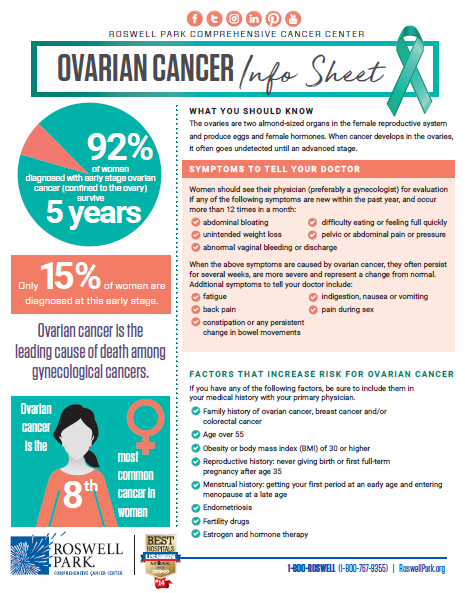Cancers of the fallopian tubes and peritoneum (the tissue that lines the abdomen and covers abdominal organs) often begin in the same kind of tissue as ovarian cancer, and receive the same treatment, so these cancers are often discussed together.
The ovaries are two walnut-sized glands in the female reproductive system, located at on each side of the uterus, near the ends of the fallopian tubes. These glands store eggs and secrete female hormones involved in menstruation and fertility.
Ovarian cancer begins in one of three ovarian cell types:
- Epithelial cells which cover the ovaries’ surface. Epithelial ovarian cancer is the most common type, accounting for nine out of ten cases. Sometimes the cancer begins in a fallopian tube or in the peritoneum and spreads to the ovary. Fallopian tube and primary peritoneal cancers are treated the same as ovarian epithelial cancer.
- Germ cells are the cells that make up individual eggs. Ovarian germ cell tumors typically occur in teenage girls or young women and affect just one ovary.
- Stromal cells which produce the female hormones, estrogen and progesterone, are found in the supporting connective tissue of the ovary.
Both germ cell and stromal cell tumors are rare and together account for less than 10 percent of ovarian cancer cases. These cancers may be treated with different chemotherapy types than epithelial tumors. Younger patients with these cancer types may be eligible for fertility-sparing surgery.
More than 19,000 new cases are estimated to be diagnosed in the United States in 2022, making ovarian (and fallopian tube and primary peritoneal) cancer, the second most common gynecologic cancer. (Uterine cancer is the most common with more than 65,950 new cases expected in 2022.)
Ovarian cancer often goes undetected due to a lack of symptoms until it reaches an advanced stage, and has spread to other organs by:
- Invading and growing into organs near the ovaries, such as the fallopian tubes and uterus.
- Shedding or breaking off from the main ovarian tumor. Shedding into the abdomen may lead to new tumors forming on the surface of nearby organs and tissues. Your doctor may refer to these new growths as seeds or implants.
- Spreading of cancer cells traveling through the lymphatic system to lymph nodes in the pelvis, abdomen, and chest. Cancer cells may also spread through the bloodstream to organs such as the liver and lungs.
When cancer advances from its original place to another part of the body, the new tumor has the same kind of abnormal cells and the same name as the original tumor. For example, if ovarian cancer spreads to the liver, the cancer cells in the liver are actually ovarian cancer cells. The disease is metastatic ovarian cancer, not liver cancer. For that reason, such tumors are treated as ovarian cancer, rather than liver cancer. Your doctor may refer to these new tumors as distant or metastatic disease.
Some ovarian tumors have abnormal cells in the tissue covering the ovary. These abnormal cells have the potential to become cancer, but usually they do not and the tumor remains confined to the ovary. (Both ovaries should be checked for disease.) Low-malignant potential tumors are usually treated with surgery.
